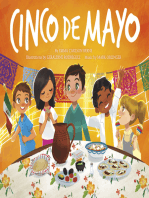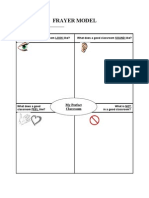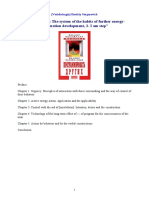Dia de Los Muertos
Dia de Los Muertos
Uploaded by
Paul SpenceCopyright:
Available Formats
Dia de Los Muertos
Dia de Los Muertos
Uploaded by
Paul SpenceCopyright
Available Formats
Share this document
Did you find this document useful?
Is this content inappropriate?
Copyright:
Available Formats
Dia de Los Muertos
Dia de Los Muertos
Uploaded by
Paul SpenceCopyright:
Available Formats
Dia de los Muertos The Day of the Dead
"Yanqui's" typically celebrate Halloween, but south of the border, the biggest celebrations of the year follow Halloween and are known as the Days of the Dead. November 1 and 2 are the Days of the Dead, when the souls of the departed return to join their families and friends in the land of the living. It is a joyous time, without the tears which can make the return pathway slippery. Skeletons, skulls and red devils are depicted happily cavorting. Even the holiday foods, the sugar candies and the breads, are molded to look like "La Calavera"the skeleton of death. In preparation for the Days of the Dead, and in anticipation of our own Halloween festivities, we present here a series of "factoids" on this traditional Mexican holiday. We invite youand your dearly departedto join us as we celebrate Los Dias de Los Muertos...Vamanos, hombres! Day of the Dead, or el Dia de los Muertos, is a happy celebration in Mexico. That's when the souls of the dearly departed return home to the world of the living. All of them. From Heaven, Hell and Purgatory, they descend upon their families and for two days, November 1 and 2, they rejoice together. Even though a family is saddened by a loved one's departure, they do not cry on the Days of the Dead. The elders say the path back to the living world must not be made slippery by tears. There are actually two Days of the Dead: November 1 and November 2, and the tradition dates back to the Aztec civilization. Coincidentally or not, these days are also the Catholic holy days of All Saints' and All Souls' days. In Mexican culture, the lines between ancient folklore and the customs of the Spanish Conquistadors frequently blur. The first Day of the Dead, on November 1, is usually reserved for the children, for honoring the souls of the little angelitos. The next day, the adults are remembered. You will see both young and old in the night's rituals, holding vigils in the town cemetery. Everywhere, round loaves, dusted with colored sugar, are shared with both the living and the dead. Preparations for the most important holidays of the year, the Days of the Dead, begin weeks in advance. Statues, candies,breads and other gifts known to please Los Muertos fill the marketplaces, and are consumed by the living with as much fervor as we do our own Christmas goods. Both the spirits and the economy get a boost at this time of year. The Aztecs believed that death was but a portal to other existencesa natural, albeit mystical, occurrence. Families paid homage to their dead, and on those days when the living and dead were reunited, they welcomed them back with great respect and reverence. This is the basis for the Days of the Dead, even today.
Calaverathe skull or skeletonis the number one symbol for the Days of the Dead. But it is not presented to terrorize. Instead, the calavera represents the playfulness of the Dead, as they mimic the Living and frolic amongst us. La Muerte is 'the bald one' of the Days of the Dead. You see La Muerte in baked goods and sugar candiesin 'calaveras de azucar'as it is widely known that the Dead love sugar. Made from a sugar paste cast in molds, the candy skulls of the Days of the Dead are decorated with colorful foil eyes and icing. Look for your namePedro, Juan, Sarina, Luisa, Alejandro, Tomas, Gabrielaif it's not there, we can make one for you in an instant. On the Days of the Dead, savor the sugar skulls, bite down and crush them in your teeth. Enjoy the sweet taste of these, La Muerte's candies, for one day, she will feast on you, too. The sugar skulls of the Days of the Dead are stacked in huge pyramids throughout the open markets of Mexico. They are considered gifts, tokens of love, and besides being eaten by all ages, they adorn home alters and grave sights. "Give me bread and sugar to help me on my journey to the next level," say the Dead before burial. The bread of the dead, pan de muerto, is sweet and baked expressly for the Days of the Dead holiday. Bring some home to your mother, serve some to your guests. See the pretty colored sugar on top? Notice those bumpsthey remind us of the bones of the Dead. On the Days of the Dead, you will see the Devil, too, as he plays and frolics with the Skeleton. He came to the holiday from the Catholics, who tell us to be saintly or be banished to Hell or Purgatory. "We must remember them", say the elders about the Dead. "They want us, they love us. See how that flame danced high before it died? It is the Dead, letting us know we are not to forget them. Look over therethat glass just tipped over. No one of the Living touched it. It is how the Dead speak to us." The Dead are full of Life. We see it in the statues, toys and trinkets of el Dia De Los Muertos. Miniature skeletons sporting mohawks and big grins play in rock bands. Paper mache skulls bear pink flowers for eyes and green lizards on their brows. Wooden skeletons on rods dance wildly, with arms and legs flailing, whenever you pull their string. The calaveras sing, dance, laughthey even ride on merry-go-rounds and drive rickety wooden trucks. And of course, they drink pulque, a fermented drink made from cactus. Picture the bride and groomaren't they handsome in their black suit and white dress! Look closer, though, this happy couple is of the Dead, with beaming grins on their skulls and boney arms jutting from their sleeves. On the Day of the Dead, everything is happy.
Looking like a tomb in the catacombs of Rome, the Mexican bakery's shelves are stacked with sugar skulls for the Day of the Dead. From a few inches to life size, these skulls stare back with gleaming foil eyes of red, green, blue, magenta...Purple, green and turquoise icing paints highlights on the nose sockets and cheek bones. without the lips of the living, the teeth protrude eerily from the jawbones. If you were in Mexico right now, preparing for the Days of the Dead, you would gather your children and teach them to prepare the ofrenda, the home altar. "Mira, muchachos, bring the pan de muerto here for your ancestors, they are hungry. Offer them a sugar skull, so they know you remember them."
Questions for Consideration: 1. When are the Days of the Dead and what are they? 2. Why is the Day of the Dead considered a happy celebration? 3. The first day of the celebration is usually reserved for what? 4. The day of the dead is a combination of what two cultures? 5. What did the Aztec's believe? 6. What is a Cavalera and what does it represent? 7. What are cavaleras de azucar? 8. Who is with the skeleton and what is his significance? 9. What are some statues, toys and trinkets seen on the holiday? 10. What is the ofrenda?
You might also like
- Holy Musical B@Man ScriptDocument106 pagesHoly Musical B@Man ScriptSaraya Danielsen100% (3)
- SOCIAL SCIENCE Classified Exam and RationalizationDocument68 pagesSOCIAL SCIENCE Classified Exam and Rationalizationitsmesabrina02141997No ratings yet
- Los Pasatiempos Project Handout and RubricDocument2 pagesLos Pasatiempos Project Handout and Rubricapi-251379727No ratings yet
- RealidadesDocument6 pagesRealidadesapi-288678089100% (1)
- Mexican Legend ''La Llorona'' (The Weeping Woman)Document2 pagesMexican Legend ''La Llorona'' (The Weeping Woman)Ana Sofia MuñizNo ratings yet
- AQA Computer Science A-Level 4.5.2 Number Bases: Advanced NotesDocument10 pagesAQA Computer Science A-Level 4.5.2 Number Bases: Advanced NotesAHMED MUSTAFA MAKINo ratings yet
- Preview: Tema 2 - La EscuelaDocument26 pagesPreview: Tema 2 - La EscuelaLLLLNo ratings yet
- Utl 640 Lote 5e Lesson Plan 9 - RevisedDocument10 pagesUtl 640 Lote 5e Lesson Plan 9 - Revisedapi-458078657No ratings yet
- American Pageant Chapter 6 NotesDocument7 pagesAmerican Pageant Chapter 6 NotesbutteredxwafflesNo ratings yet
- 1 ADocument24 pages1 Aapi-319889669100% (1)
- Day 1 La Llorona Lesson PlanDocument3 pagesDay 1 La Llorona Lesson Planapi-487660366No ratings yet
- FINAL Quieting of Title ANSWERDocument7 pagesFINAL Quieting of Title ANSWERCharmaine Casquejo50% (2)
- ProjectileMotionSimulationusingPHET 1Document2 pagesProjectileMotionSimulationusingPHET 1yesNo ratings yet
- El Dia de Los MuertosDocument18 pagesEl Dia de Los MuertosShubham JaydipNo ratings yet
- Dia de Los MuertosDocument28 pagesDia de Los MuertosJohn Hower100% (1)
- Culture QuestionsDocument3 pagesCulture Questionsapi-288469731100% (1)
- Spanish 1 El Dia Escolar Donde Esta WaldoDocument2 pagesSpanish 1 El Dia Escolar Donde Esta Waldoapi-2632674690% (1)
- Spanish CultureDocument2 pagesSpanish CultureJohnson AnthonyNo ratings yet
- Spanish 2, Unit 6, TareaDocument2 pagesSpanish 2, Unit 6, Tareaapi-263267469100% (1)
- Canela Movie Questions 2Document4 pagesCanela Movie Questions 2api-2507123400% (1)
- Dia de Muertos MexicoDocument13 pagesDia de Muertos MexicoFlorencia Mackenzie Camacho100% (1)
- Spanish 1 Buen Provecho Vamos Al SupermercadoDocument1 pageSpanish 1 Buen Provecho Vamos Al Supermercadoapi-263267469No ratings yet
- American Pageant Chapter 5 NotesDocument5 pagesAmerican Pageant Chapter 5 NoteslbNo ratings yet
- Day of The Dead CrosswordDocument1 pageDay of The Dead CrosswordClaudia IñiguezNo ratings yet
- Zach Wells - SpanglishDocument8 pagesZach Wells - Spanglishapi-374985159No ratings yet
- Dia de Los MuertosDocument8 pagesDia de Los Muertosapi-277390087No ratings yet
- Spain WebquestDocument6 pagesSpain Webquestapi-329313103No ratings yet
- Holiday Vocabulary & Christmas Celebrations in Spanish Speaking WorldDocument2 pagesHoliday Vocabulary & Christmas Celebrations in Spanish Speaking WorldJoaquin100% (1)
- Spanish III SyllabusDocument3 pagesSpanish III Syllabusapi-261606263No ratings yet
- Student Viewing Guide Selena.240192853Document3 pagesStudent Viewing Guide Selena.240192853mgb_543No ratings yet
- Español 3 Señora Salas: ¡Bienvenidos!Document12 pagesEspañol 3 Señora Salas: ¡Bienvenidos!api-367854711No ratings yet
- Latin America Study GuideDocument4 pagesLatin America Study Guideapi-312250809No ratings yet
- Spanish 1 RestaurantprojectDocument3 pagesSpanish 1 Restaurantprojectapi-347696979No ratings yet
- 1-C-A Día de Los Muertos 1Document1 page1-C-A Día de Los Muertos 1Natacha De Paula100% (1)
- Introduction To Spanish - ComicDocument4 pagesIntroduction To Spanish - ComicJoaquinNo ratings yet
- ACTFL Flipping The ClassroomDocument4 pagesACTFL Flipping The ClassroomTerriPlezNo ratings yet
- Read Draw Ask Sub PlanDocument2 pagesRead Draw Ask Sub PlanCrystal Barragán100% (1)
- All Spanish 2 Objectives-2Document15 pagesAll Spanish 2 Objectives-2JoaquinNo ratings yet
- Spanish 1Document96 pagesSpanish 1PennyNo ratings yet
- El Libro de La VidaDocument27 pagesEl Libro de La VidaLive LiveNo ratings yet
- LacasachoiceboardDocument2 pagesLacasachoiceboardapi-235730203No ratings yet
- Unit Plan Brooke Leeder Grade 2 Spanish Bilingual: AssessmentDocument5 pagesUnit Plan Brooke Leeder Grade 2 Spanish Bilingual: Assessmentapi-385686971No ratings yet
- Unidad de Estudio México (En Español) MEXICAN HISTORY UNIT (SPANISH)Document44 pagesUnidad de Estudio México (En Español) MEXICAN HISTORY UNIT (SPANISH)Philip Pasmanick100% (1)
- Pretérito Imperfecto de Subjuntivo: Verbos Regulares e IrregularesDocument15 pagesPretérito Imperfecto de Subjuntivo: Verbos Regulares e Irregularesswatson033No ratings yet
- La Comida - TemaDocument24 pagesLa Comida - TemaSimohamed Belhaj100% (1)
- Mi Familia Day 1Document3 pagesMi Familia Day 1Joaquin100% (2)
- Weekly Lesson Plan - World Languages: Name Subject & Language Level Essential Week of ToDocument7 pagesWeekly Lesson Plan - World Languages: Name Subject & Language Level Essential Week of ToRaul100% (1)
- Frayer Classroom Day1Document2 pagesFrayer Classroom Day1Joaquin100% (1)
- Mexican Traditions For ChristmasDocument2 pagesMexican Traditions For ChristmasJoaquin100% (1)
- Spanish II Curriculum Map 2018Document3 pagesSpanish II Curriculum Map 2018api-292537301No ratings yet
- Proyecto Espaol 2 El MenuDocument3 pagesProyecto Espaol 2 El Menuapi-261609878No ratings yet
- Verba Hispanica 22Document248 pagesVerba Hispanica 22JelicaVeljovicNo ratings yet
- Hispanic Heritage Digital Presentation or Poster ProjectDocument2 pagesHispanic Heritage Digital Presentation or Poster Projectapi-368465474No ratings yet
- Restaurant Menu ResearchDocument3 pagesRestaurant Menu Researchapi-237358910100% (1)
- Free-download-Calico Spanish Sing Color ActivitiesDocument14 pagesFree-download-Calico Spanish Sing Color Activitieslern materialNo ratings yet
- Spanish 1 Mi Familia TareaDocument1 pageSpanish 1 Mi Familia Tareaapi-263267469No ratings yet
- 4A Lesson PlansDocument17 pages4A Lesson PlansYuvika Gupta50% (2)
- BoggleGameRealidades24bSpanishVocabularymannersspecialevents PDFDocument2 pagesBoggleGameRealidades24bSpanishVocabularymannersspecialevents PDFMaria Dolores Barrionuevo Alvarez100% (1)
- Spanish 4h Syllabus 2018 - 2019Document6 pagesSpanish 4h Syllabus 2018 - 2019api-326518258No ratings yet
- Test Rutina DiariaDocument4 pagesTest Rutina DiariaNadia GradeaNo ratings yet
- Realidades UnitsDocument3 pagesRealidades Unitsmktkelley100% (4)
- Holidays and Celebrations/Los Dias de Fiestas y Las CelebracionesFrom EverandHolidays and Celebrations/Los Dias de Fiestas y Las CelebracionesNo ratings yet
- Ecss e 10 02aDocument144 pagesEcss e 10 02aasantori6133No ratings yet
- CogBio - Lecture 11 - Motor System - Student - PDTDocument22 pagesCogBio - Lecture 11 - Motor System - Student - PDTsofiaNo ratings yet
- Revised Forestry CodeDocument6 pagesRevised Forestry CodeRyan AcostaNo ratings yet
- Khatravath 2015Document7 pagesKhatravath 2015Shakuntal KhamarNo ratings yet
- Sue Halpern - A Dog Walks Into A Nursing Home (Extract)Document31 pagesSue Halpern - A Dog Walks Into A Nursing Home (Extract)Allen & UnwinNo ratings yet
- Situational InfluencesDocument48 pagesSituational Influenceskitti123prasadNo ratings yet
- Engleski 3 K2Document4 pagesEngleski 3 K2Slavisa VeljkovicNo ratings yet
- Hw5-5S: Decision Theory - Online HomeworkquestionDocument2 pagesHw5-5S: Decision Theory - Online Homeworkquestionsubash1111@gmail.comNo ratings yet
- Full Report of Mini ProjectDocument23 pagesFull Report of Mini ProjectNarsyida Niasara HamdanNo ratings yet
- Livre Deir 3 - enDocument103 pagesLivre Deir 3 - ennepherNo ratings yet
- Palmerhermeneutics PDFDocument40 pagesPalmerhermeneutics PDFn rikeNo ratings yet
- Report Card (FORM 138)Document4 pagesReport Card (FORM 138)LeonorBagnisonNo ratings yet
- Women's Role in Leading OrganizationsDocument12 pagesWomen's Role in Leading Organizationsdiana nistoranNo ratings yet
- Language Shift-1Document12 pagesLanguage Shift-1karina lesleyNo ratings yet
- 2011 Baeza Garcia Tent Journal of Iberian GeologyDocument15 pages2011 Baeza Garcia Tent Journal of Iberian GeologyLuis AndresNo ratings yet
- Johari S WindowDocument2 pagesJohari S WindowDanica Rose FeguracionNo ratings yet
- Mix VarianceDocument1 pageMix VarianceClaire BarrettoNo ratings yet
- About TOEFLDocument16 pagesAbout TOEFLhepinaNo ratings yet
- (Dan Geller) Instant StrategistDocument134 pages(Dan Geller) Instant StrategistNoel Martin100% (1)
- Mkultra CIA v. SimsDocument60 pagesMkultra CIA v. Simsmary engNo ratings yet
- Algebraic Criterion For StabilityDocument57 pagesAlgebraic Criterion For StabilityPhani Sarma NagavarapuNo ratings yet
- Grade 1 Story Elements ADocument3 pagesGrade 1 Story Elements AVendettaNo ratings yet
- 01-06 MAC Swap Loopback ConfigurationDocument14 pages01-06 MAC Swap Loopback ConfigurationSusana Contreras GuerreroNo ratings yet
- Banee Israaeel 09Document6 pagesBanee Israaeel 09NL GamerNo ratings yet
- Hayman July 07Document5 pagesHayman July 07grumpyfeckerNo ratings yet

























































































